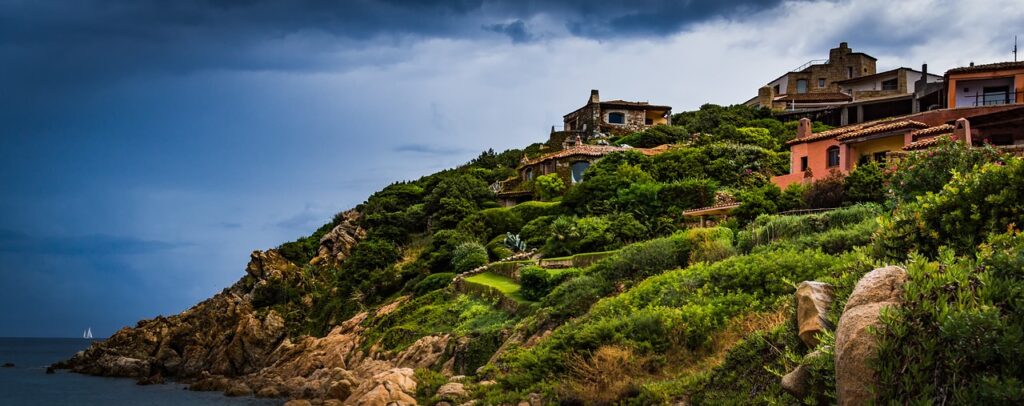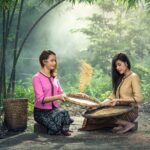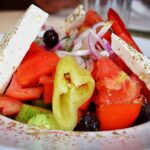Is Sardinia the definitive “Paradise” on Earth?! The turquoise waters of its beaches that stretches for miles, the contemporary semi-tropical weather, the food which is basically where the Mediterranean diet came from, and the lifestyle of the people living here all perfectly blends into the most ideal environment that I can think of.
A major feature of the countryside of this Mediterranean jewel is olive trees and the high quality olive oil they produce is a staple of this Blue Zone’s diet.
You may find it surprising to see 99-year olds still herding goats and climbing up and down the 30° – 40° angle slopes of Sardinia Island in Italy. Some centenarians walk the streets carefree walking upright without any assistance from canes or any artificial medical devices and occasionally eat gelato (the equivalent of Western ice cream, except it’s healthier). You will definitely notice that there are a couple of hundred elderly people going about the streets and public places on this island and most of them are probably centenarians too!
Blue Zones
“Blue Zone” is a non-scientific term given to geographic regions that are home to some of the world’s oldest people. Sardinia just happens to be one of the Blue Zone areas in the world where people live the longest, healthiest lives. Other Blue Zone areas include Ikaria, Greece; Okinawa, Japan; Nicoya, Costa Rica; and the Seventh-day Adventist community in Loma Linda, California.
The term was coined by author Dan Buettner, who was studying geographical locations on the planet in which people had unusually long lifespans. This phrase which has become an icon came into being, because Buettner and his colleagues marked the areas that they were looking for on a map with blue circles.
Longevity in Sardinia
To better understand the Sardinian’s philosophy for long life, we need to go back 2 decades in the year 2001 and look at the life of one Antonio Todde. People often referred to him as Tziu Antoni (“Uncle Tony”) and it’s interesting to know that he lived up to 112 years old before passing and being a native of Sardinia’s Nuoro province he had been a shepherd all his life. You don’t hear every day that someone actually had lived up to 112 years old and yet in Sardinia it’s something they consider normal.
Uncle Tony’s secret to his long life? According to him he enjoyed long walks and a simple diet based on pasta, vegetable soup, red meat, and cheese. Uncle Tony was gracious enough to grant an interview with BBC before he passed away and according him, his secret to living a long life includes,
“Just love your brother and drink a good glass of red wine every day. You take one day after the other, you just go on.”
While there’s more to it than what he said, he may already have scratched the surface of what might be a huge golden pyramid hidden in the middle of nowhere that you won’t be able to find without a treasure map. But I’m sorry to say that science doesn’t have all the answers when it comes to determining the reason behind the Sardinian’s longevity. Because ultimately scientists narrowed it down to 4 things:
- Diet
- Physical activity
- Community life, and
- Inherited genes
I will tell you now; there is no science for community life or happiness. It’s something beyond what we can measure and that’s okay, because it makes it more compelling with it being mysterious and all. It makes us actually want to pursue it and live our lives to the fullest. Oh! And yeah, the Sardinians are already doing it and they’re doing it very well, so we can start by copying them.
1. A Tasty Spin on the Mediterranean Diet
According to Dan Buettner, the man largely responsible for identifying the five Blue Zones sprinkled across the globe, the Sardinian diet (a.k.a. the Mediterranean diet) may be responsible for around 25 percent of a person’s chance of living up to 100 years old. The Sardinian diet has plenty of similarities to the Mediterranean diet that many believe the latter is a derivative of the former. For example, it includes lots of freshly grown garden vegetables, fruits, healthy fats, legumes, whole grains and some dairy, seafood, and meat (mainly pork and lamb).
Like the Mediterranean diet, the food in Sardinia is based 60% edible plants, while meat is only consumed during special occasions or every weekends (depending on the people’s preferences). Lunch brings the whole family (and sometimes even the whole community) together, and and dinner is kept nice and light.
The most common source of edible fat in the island is olive oil and this is also the type of fat used in most Blue Zones. Today, in the island of Sardinia, there are approximately 6 million olive trees spread across 40,000 hectares of olive groves divided into 52,000 privately owned farms. Every year these olive trees yield 10,000 tons of olive oil which means the locals will never run out of supply of this liquid gold. There are 28 known cultivars (varieties) of olive oil in the island; however, the best variety is the Bosana. Each region of cultivation has its own unique flavor and aroma to their olive oil product, and in some cases, you may notice aromas of fresh grass, unripe banana, tomato stalk, or bitter almond and a spicy kick reminiscent of black pepper or ginger. You will know if an olive oil product has the highest quality and high amount of health-promoting polyphenol compounds when it has a pleasant burn aroma.
Because Sardinia is just a small island and there aren’t a lot of cows and other livestock to harvest meat from, most people become naturally shepherds due to the large population of sheep. Sheep produce dairy products including the traditional consume pecorino cheese made from the milk of grass-fed sheep. This cheese is known to contain a higher amount of the anti-CVD omega-3 fatty acids compared to other cheeses. Lamb meat is one of their favorite meat choices too! When it comes to dairy products Sardinians drink goat’s and cow’s milk primarily, they also eat gioddu (a traditional yogurt) which they eat with a drizzle of honey in some occasions.
The fiber-rich barley is their main source of whole grain in Sardinia Island. Meanwhile, coastal villages get their protein from fish, such as gurnard, sea robin, eel, skate, bream, and mullet along with tiny squid or octopus, baby clams, and small crabs.
The staple red wine in Sardinia is called “cannonau” and is probably what Uncle Teddy drank a glass each day when he was still alive. This red wine is made from grenache grape, which also has a higher amount of antioxidants than other types of grapes, and typically served in a glass that’s just bigger than a shot glass. However, Sardinians do not stop at 1 glass, especially when they’re hanging out with friends and having fun – it is a mandate of local tradition. In case you’re wondering how Sardinians prepare their dishes from the available resources on the island, then just look at some of their recipes listed below:
- Minestrone soup
- Seafood fregola (similar to paella, except this one has fregola pasta)
- Seafood stew with octopus
- Clams and more
- Stuffed eggplant with freshly grated pecorino
- Lamb kebabs over couscous
- Grilled artichokes with herbs
- Delicious salads with ingredients like tomato, fennel, olives, and an array of herbs dressed with extra virgin olive oil and vinegar
Recommended Reading: Other Diet Plans Versus The Mediterranean Diet
2. Lots of Low- and Medium-Impact Movement
Sardinia’s land area is around 24,090 km2 (9,300 mi2) where nearly half of the island is a mountainous region where goat herders and shepherds take their goats and sheep to lounge and eat grass all day. This prompts Sardinians to walk around the island instead of riding a vehicle. This also essentially makes them physically active for more than 70% of their lifetime and these low and medium impact movement helps them burn calories effectively on a daily basis that they don’t need to go to the gym to do it. It’s not uncommon for a Sardinian shepherd to walk five miles a day over uneven terrain, which provides a range of benefits for cardiovascular, bone, and joint health. They also get the bonus of getting a health boost from it on top of the food they eat.
“They are getting low intensity and medium intensity exercise all the time,” said Buettner in a recent interview with NBC News. “There are dozens of periods of physical exertion throughout the day, and people aren’t driving for the most part; they’re walking.”
I’m not saying that you should switch careers and go be a shepherd in Sardinia, but I think you can find ways to be as physically active as those centenarians in that tiny island. Taking periodic walks, using the stairs instead of the elevator in your office, doing a quick yoga flow during your lunch break, doing a 15 – 30 minute planking, pruning your plants in your garden and maybe removing the weeds too, and plan on going on some wonderful hiking trails every weekends (if you can).
3. A Strong Sense of Humor and Community
Our ancestors used to say that laughter is the best medicine, but new studies suggest they were right. For example, this article says that having a good sense of humor can add 8 more years to your average life span. While the Scientific American also says the same thing, it’s no wonder why there are literally hundreds of centenarians in Sardinia! They have a strong commitment to good humor and maintaining close relationships. Foreign observers noted that it is the men in Sardinia who are known for their sardonic sense of humor, and as a matter of fact, they occasionally gather in the streets every afternoon to laugh with (and at) each other.
Researchers say that laughter is associated with reduced stress, improved immunity, and heart health. This plus their amazing diet, geographical location and having a closely knitted community all contribute to extending their lives further than on other places on Earth (those non-Blue Zones). Okay, I know it’s not easy to find a group of hilariously crotchety old men to laugh with every day, but I’m saying that you should find a way to laugh a little. Spend time with you friends – I’m sure you have the chemistry to make fun of things and yourselves, or you could also go to stand-up comedy clubs or something. Basically just enjoy life and don’t take things or yourself too seriously.
4. A Deep Respect for Aging Relatives
I guess, the differences in our cultures give the Sardinians more advantages over us when it comes to health and wellness. While more than half of Americans aged 70 and above will be sent to a nursing home, in Sardinia they continue to live with their relatives all the way up to their 90s, and if they’re lucky (which they are more often than not) they will live with them until their death. Compared to the average elderly American, Sardinians don’t just lounge around all day, no, they help take care of the children, keep dietary traditions alive, cultivate their family garden and do a lot more stuff that are pretty heavy physically for someone at their age.
I call it “value exchange,” where the elderly folks gets a true sense of purpose and inspiration even in their twilight years (which is the key to prolonging life), and the younger generation gets to experience rare irreplaceable wisdom. Dan Buettner also observed how households with grandparents living with the family tend to make children healthier and have less disease, they’re happier, do their chores and homework better (they also do good in school). He called this the “grandmother effect,” where he describes this virtuous circle explains why people live longer in Sardinia and other Blue Zones.








One Response
Wow! Didn’t know that there are a lot of centenarians in Sardinia! Better start thinking about my eating habits.